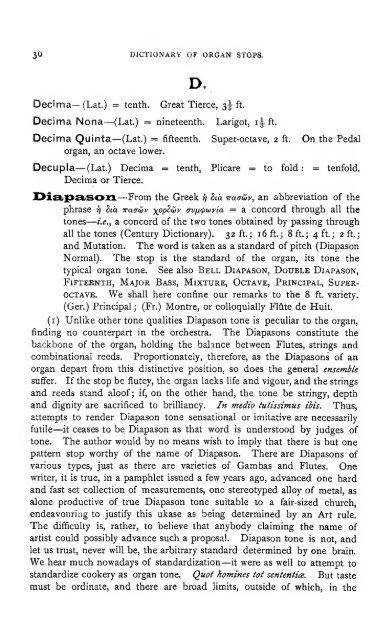A comprehensive dictionary of organ stops - Allen Organ Studio of ...
A comprehensive dictionary of organ stops - Allen Organ Studio of ...
A comprehensive dictionary of organ stops - Allen Organ Studio of ...
Create successful ePaper yourself
Turn your PDF publications into a flip-book with our unique Google optimized e-Paper software.
3&<br />
DICTIONARY OF ORGAN STOPS.<br />
Decima— (Lat.) = tenth. Great Tierce, 3^ ft.<br />
Decima Nona—(Lat.) = nineteenth. Larigot, 1^ ft.<br />
Decima Quinta— (Lat.) = fifteenth. Super-octave, 2 ft. On the Pedal<br />
<strong>organ</strong>, an octave lower.<br />
Decupla— (Lat.) Decima = tenth, Plicare = to fold: = tenfold.<br />
Decima or Tierce.<br />
Diapason—From the Greek f/ Sia iraadv, an abbreviation <strong>of</strong> the<br />
phrase ri Zia iraaHv x°pdv arv/x^wvia = a concord through all the<br />
tones<br />
—<br />
i.e., a concord <strong>of</strong> the two tones obtained by passing through<br />
all the tones (Century Dictionary). 32 ft.; 16 ft.; 8 ft.; 4 ft.; 2 ft.;<br />
and Mutation. The word is taken as a standard <strong>of</strong> pitch (Diapason<br />
Normal). The stop is the standard <strong>of</strong> the <strong>organ</strong>, its tone the<br />
typical <strong>organ</strong> tone. See also Bell Diapason, Double Diapason,<br />
Fifteenth, Major Bass, Mixture, Octave, Principal, Super-<br />
octave. We shall here confine our remarks to the 8 ft. variety.<br />
(Ger.) Principal; (Fr.) Montre, or colloquially Flute de Huit.<br />
(1) Unlike other tone qualities Diapason tone is peculiar to the <strong>organ</strong>,<br />
finding no counterpart in the orchestra. The Diapasons constitute the<br />
backbone <strong>of</strong> the <strong>organ</strong>, holding the babnce between Flutes, strings and<br />
combinational reeds. Proportionately, therefore, as the Diapasons <strong>of</strong> an<br />
<strong>organ</strong> depart from this distinctive position, so does the general ensemble<br />
suffer. If the stop be fiutey, the <strong>organ</strong> lacks life and vigour, and the strings<br />
and reeds stand alo<strong>of</strong>; if, on the other hand, the tone be stringy, depth<br />
and dignity are sacrificed to brilliancy. In medio tutissimus ibis. Thus,<br />
attempts to render Diapason tone sensational or imitative are necessarily<br />
futile—it ceases to be Diapason as that word is understood by judges <strong>of</strong><br />
tone. The author would by no means wish to imply that there is but one<br />
pattern stop worthy <strong>of</strong> the name <strong>of</strong> Diapason. There are Diapasons <strong>of</strong><br />
various types, just as there are varieties <strong>of</strong> Gambas and Flutes. One<br />
writer, it is true, in a pamphlet issued a few years ago, advanced one hard<br />
and fast set collection <strong>of</strong> measurements, one stereotyped alloy <strong>of</strong> metal, as<br />
alone productive <strong>of</strong> true Diapason tone suitable to a fair-sized church,<br />
endeavouring to justify this ukase as being determined by an Art rule.<br />
The difficulty is, rather, to believe that anybody claiming the name <strong>of</strong><br />
artist could possibly advance such a proposal. Diapason tone is not, and<br />
let us trust, never will be, the arbitrary standard determined by one brain.<br />
We hear much nowadays <strong>of</strong> standardization— it were as well to attempt to<br />
standardize cookery as <strong>organ</strong> tone. Quot homines tot senlentice. But taste<br />
must be ordinate, and there are broad limits, outside <strong>of</strong> which, in the


